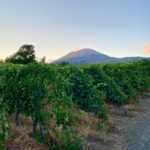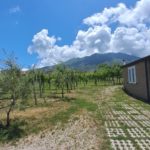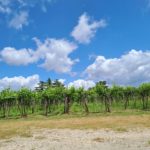Discovering Campania’s Wine Heritage at Campania Stories 2025

Despite its fragmented landscape and diverse soils and climate, the Campania region in southern Italy presents a unified face to the wine world once a year through the Campania Stories event. This year’s wine show was held in the Vesuvius area from May 18-21, featuring more than 90 producers from across Campania. The event provided an incredible opportunity for wine journalists and professionals to taste wines from this distinctive region. Each year, a new location hosts the tasting. This time, Campania Stories was arranged at the foothills of active volcano Vesuvius. Miriade & Partners, a local communication agency, managed the event. The opening presentation took place at Palazzo Mediceo in Ottaviano, a historical villa that overlooks the surrounding landscape. This was an excellent opportunity to discover wines from the inland areas of Naples province, where vines grow in the shadow of Vesuvius, protected by this 1,200-meter-high volcano from sea breezes.
Campania’s Wine Production

Campania ranks as Italy’s 8th largest wine-producing region, accounting for 4% of Italian wine production with approximately 1.7 million hectoliters per year. While the majority of production is red wine, there is also substantial white wine production, particularly from the Sannio area. The region’s wine production operates under 4 DOCG and 15 DOC appellations, one of which is Vesuvio.
The Historic Vesuvius Wine Region

The Vesuvius area is one of Campania’s oldest wine regions, with the first vine plantations dating back to the 5th century BC. The Greeks and Romans advanced viticulture in the area, introducing new grape varieties and exploiting the soil’s diversity. Viticulture in the Vesuvius area can be divided into two regions: IGP Monte Somma (the rim of the original volcano that collapsed after the 79 AD eruption) and Vesuvius DOP. While Vesuvius wines are better known, Monte Somma also displays intriguing characteristics, with vineyards extending up to 700 meters above sea level and north-facing slopes that benefit from cooling altitude and descending air currents.

The Vesuvio DOP area experiences several climatic influences, including sea breezes from the Gulf of Naples and protection from the Lattari Mountains and Apennines, which shield the area from severe frosts. Additionally, the active volcano has contributed through successive eruptions to enrich the soil with potassium and pyroclastic deposits. Protected from major lava flows, the Monte Somma area maintains pristine nature with forests and fruit trees, including the typical apricot locally called “crisommola.” With wide diurnal temperature ranges and diverse climatic influences, wines from this area are austere in youth but show great aging potential under the Monte Somma IGP appellation. The area under the Vesuvio DOP appellation faces south and is one of the region’s main tourist destinations, with thousands of visitors annually exploring the volcano and surrounding attractions. With its coastal exposure, vineyards on Vesuvius’s slopes benefit from proximity to the sea and its climatic influence, resulting in riper fruit and more full-bodied wines. The entire territory falls within Vesuvius National Park, a biodiversity heritage site.
Ancient Grape Varieties
The main grape varieties grown here have ancient origins, including Caprettone (white) and Piedirosso (red)—native varieties, some ungrafted due to the volcanic soil’s natural protection against phylloxera spread. This represents incredible wealth for local producers who propagate old productive vines by layering their shoots to preserve this heritage.

One minor variety successfully grown in this area and included only in Monte Somma IGT wines is Catalanesca, an ancient grape originally from Catalonia, Spain. According to legend, in the 15th century, Lucrezia d’Alagno received Catalanesca vine cuttings from King Alfonso I, her lover, during their stay in Somma Vesuviana near Naples. Since then, Catalanesca has adapted well to the volcanic soil of Vesuvius’s slopes and is now considered native. The grape is so well-suited to this growing environment that the berry and cluster shape change completely when planted elsewhere. Catalanesca resembles a table grape and was considered as such until the 1990s. The loose clusters, large berries, lignified stems, and dramatic acidity drop during ripening made this grape suitable only as a table grape. The resulting wine is also prone to oxidation, but in 2011 it was included in the Monte Somma IGT appellation. The wine is semi-aromatic, tending to be floral, crisp, and salty with a pleasant tannic mouthfeel due to thick skins. It reaches its peak 2-3 years after harvest. Some samples from the few producers making wine from this grape variety were outstanding, with detailed tasting notes to follow.
Acknowledgments
Special thanks to Diana Cataldo and Massimo Iannaccone from Miriade & Partners for this exceptional experience at Campania Stories 2025. I eagerly anticipate the next edition, which will be hosted at the Reggia di Caserta, Campania’s Versailles palace! During the Campania Stories, some fantastic territories were explored on the press trips. Alessia Canarino, my collaborator, visited some great wineries and provided the following report.

Tasting Notes:
Villa Dora Pompeiano IGT rosato Gelsorosa 2024
Herbal notes and flowers. Very light body, refreshing, lean.
Bosco de’ Medici Pompeiano IGT rosato Bio 2024
Wild strawberry, raspberry, zesty, full, slightly tannic, warm
Cantina del Vesuvio Winery Russo Family Lacryma Christi del Vesuvio DOC rosato 2024
Prune, appley, herbal, fruit forward. Refreshing, with clean orange notes.
Casa Setaro Lacryma Christi del Vesuvio DOC rosato Munazei 2023
Citrus notes and blossom. Herbal, green, slightly almondy finish, mildly tannic.
De Falco Vini Vesuvio DOC PIedirosso Pietranera 2023
Deep ruby, balsamic, herbal, bell pepper, capsicum, fresh green grass. Coarse, drying tannins, but well balanced.
Bosco de’ Medici Pompeiano IGT rosso Agathos Bio 2023
Bright and translucent, cranberry, red plum and red berries. Earthy, with lingering licorice notes. Dry, red tangerine, blood orange.
Astroni Campi Flegrei DOC Piedirosso Colle Rotondella
Ripe black fruit – blueberry, strawberry candy, raspberry jam. Citrusy, refreshing on mouth very well balanced. Elegant, classy, ripe smooth tannins.
Cantina del Vesuvio Winery Russo Family Since 1930 Lacryma Christi del Vesuvio DOC Rosso Superiore Bio 2023
Deep ruby, black pepper, smoke, toast. Dried fruit (walnuts). Warm, dry, grippy tannins.
De Falco Vini Lacryma Christi del Vesuvio DOC Rosso Superiore Lahar 2023
Multilayer, balsamic, earthy, dried fruit. Sweetish at the beginning, warm, balanced. Smooth, ripe, drying tannins, well balanced. Citrusy backtaste.
Casa Setaro Lacryma Christi del Vesuvio DOC Munazei Rosso Bio 2024
Pale ruby, light in the glass, black ripe fruit, black plum, balsamic notes. Warm, balanced, enveloping, smooth, ripe tannins, chalky tannins.
Tenuta Augustea Lacryma Christi del Vesuvio DOC Era 79 2022
Some evolutionary notes, coming from oak. Dried walnuts, smoke, toast, overripe red plum, red berries, cloves, vanilla. Elegant, smooth, ripe, balanced. Lingering on citrusy notes, blood orange.
Masseria dello Sbirro Lacryma Christi del Vesuvio DOC Divo Januario 2022
Deep ruby – garnet shaded, great intensity of blood orange, oaky notes and dried wood. Smooth, velvety tannins, licorice. Balsamic, earthy.
Villa Dora Lacryma Christi del Vesuvio DOC Forgiato 2020
Ripe black plum, floral, delicate. Smooth, ripe tannins, balanced. Alcohol well balanced by the refreshing taste. Lingering and clean.
Casa Setaro Lacryma Christi del Vesuvio DOC Riserva Don Vincenzo 2020
Bright, balsamic, ripe and herbal notes. Touch of earthiness and leather. Balanced smooth, elegant, ripe tannins.